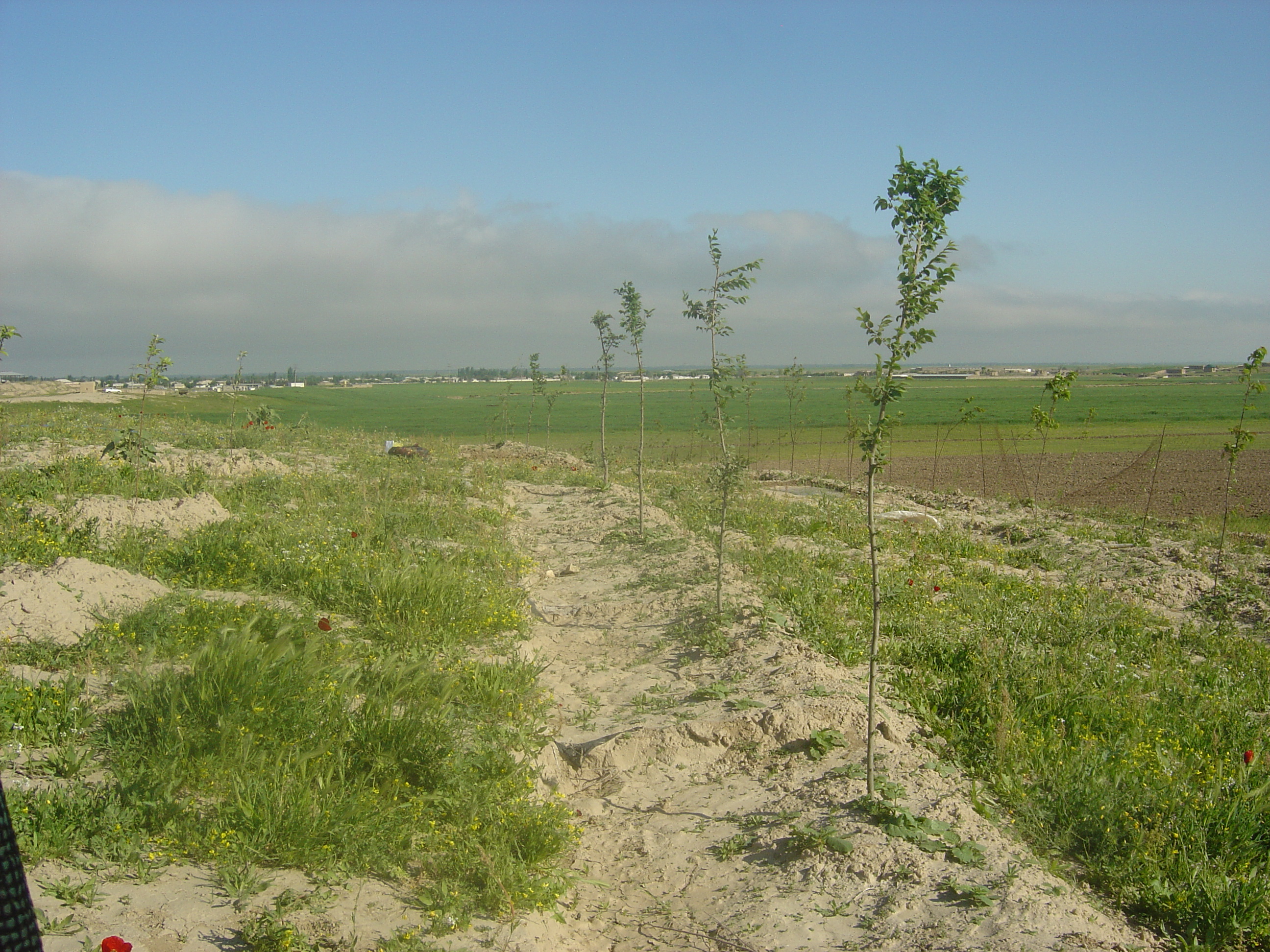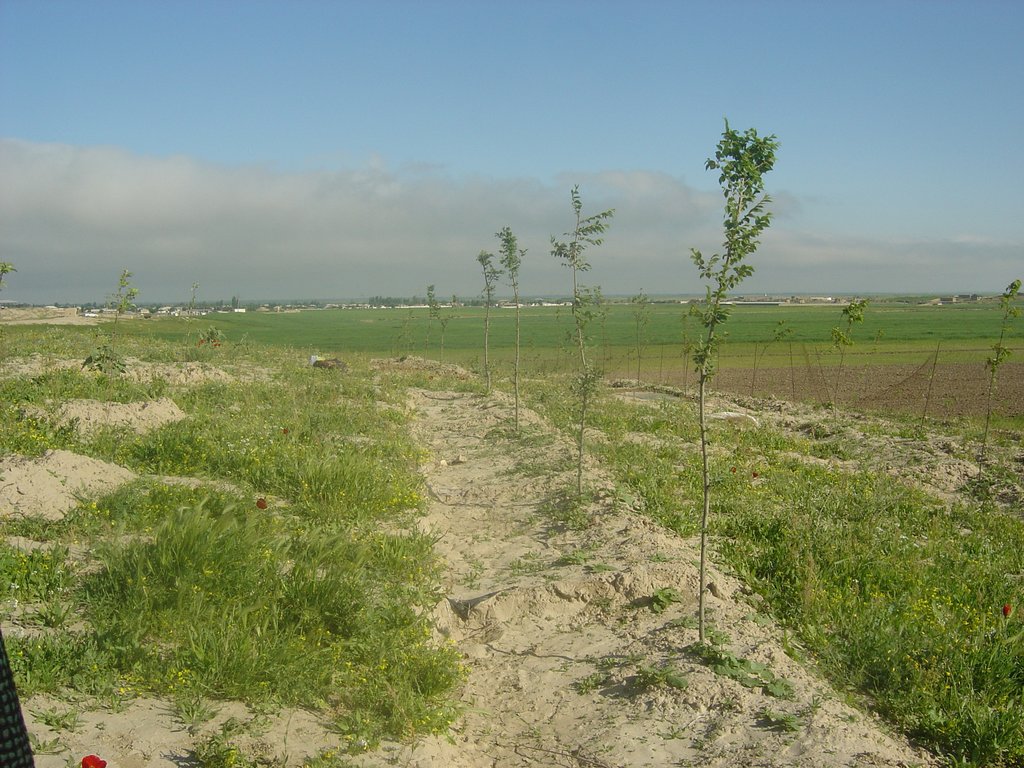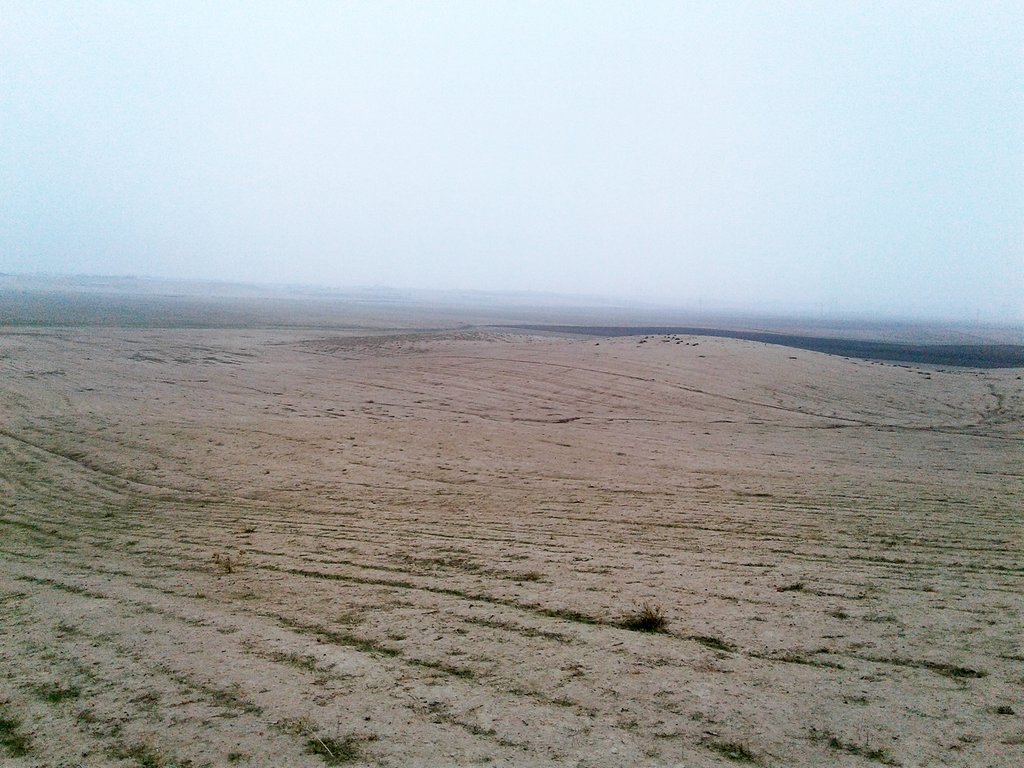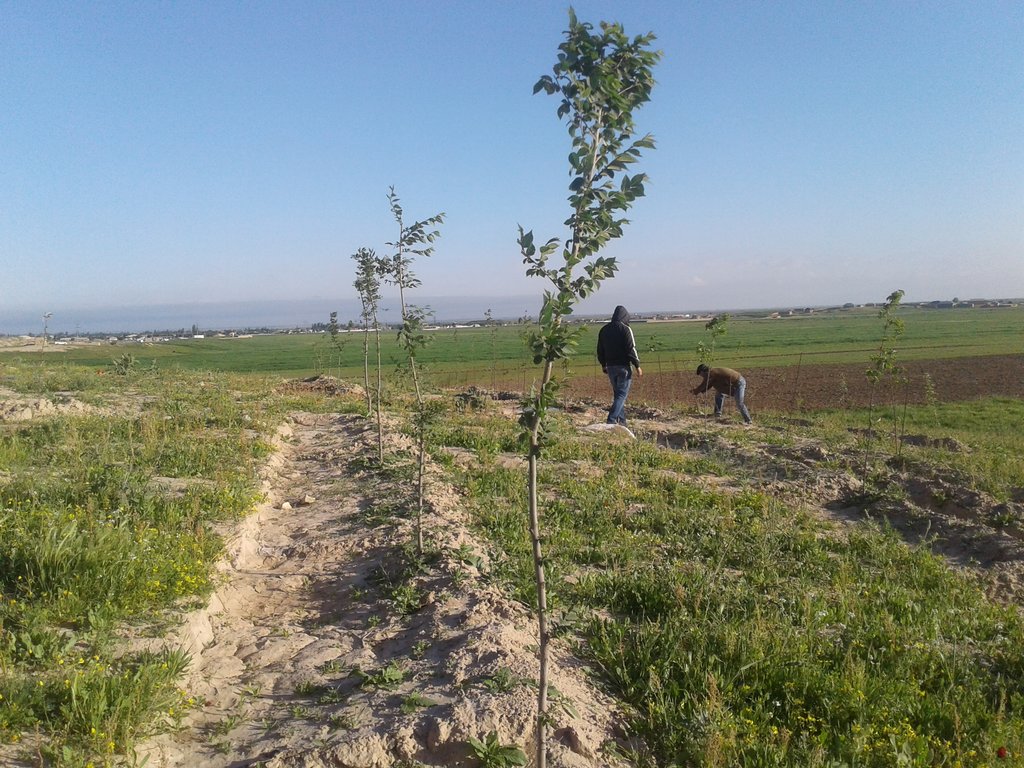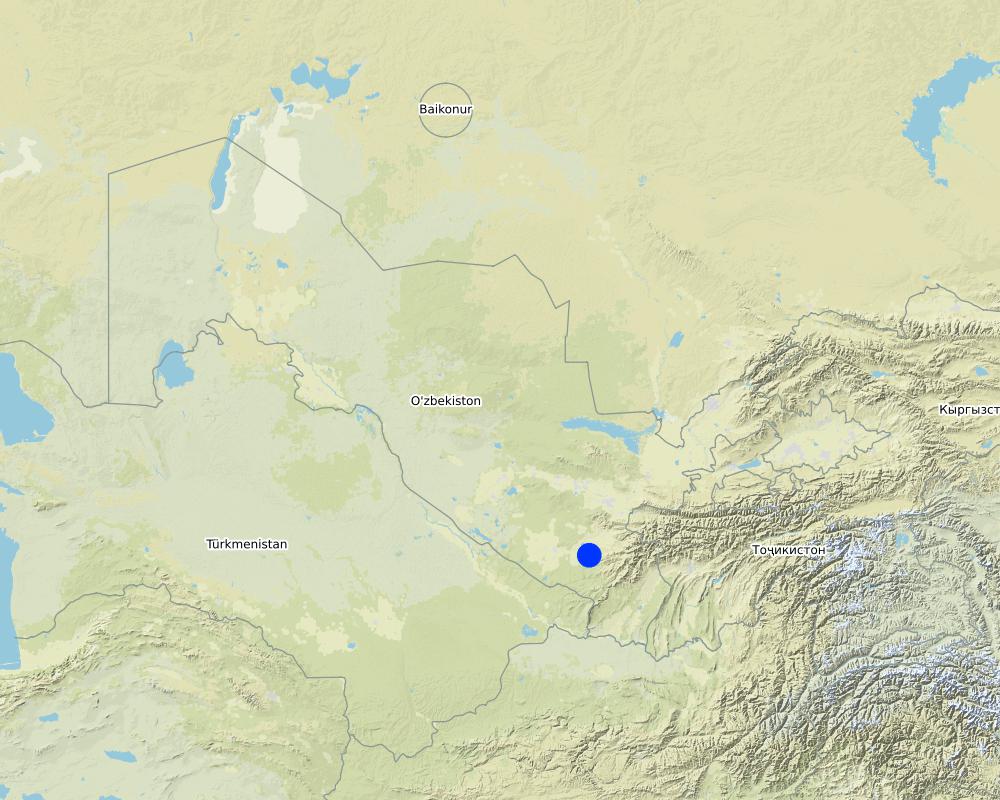Almond planting on shallow terraces to increase the efficiency of rainfed lands and to prevent erosion [Uzbekistan]
- Creation:
- Update:
- Compiler: Rustam Ibragimov
- Editor: –
- Reviewers: Alexandra Gavilano, Elizaveta Soloveyva, Olga Andreeva
Almond planting on shallow terraces to increase the efficiency of rainfed lands and to prevent erosion
technologies_3654 - Uzbekistan
- Full summary as PDF
- Full summary as PDF for print
- Full summary in the browser
- Full summary (unformatted)
- Посадка миндаля на мелких террасах для повышения эффективности богарных земель и предотвращение эрозии: Aug. 24, 2018 (inactive)
- Посадка миндаля на мелких террасах для повышения эффективности богарных земель и предотвращение эрозии: Aug. 22, 2019 (inactive)
- Almond planting on shallow terraces to increase the efficiency of rainfed lands and to prevent erosion: Feb. 3, 2020 (public)
View sections
Expand all Collapse all1. General information
1.2 Contact details of resource persons and institutions involved in the assessment and documentation of the Technology
Key resource person(s)
SLM specialist:
Mukimov Tolibjon, Khudaykulovich
Research Institute of Karakul Breeding and Desert Ecology
Uzbekistan
1.3 Conditions regarding the use of data documented through WOCAT
The compiler and key resource person(s) accept the conditions regarding the use of data documented through WOCAT:
Yes
1.4 Declaration on sustainability of the described Technology
Is the Technology described here problematic with regard to land degradation, so that it cannot be declared a sustainable land management technology?
No
2. Description of the SLM Technology
2.1 Short description of the Technology
Definition of the Technology:
Almonds and other drought-tolerant tree species are planted in rainfed zone, poor in precipitation, on shallow terraces on gentle slopes. Tree plantations prevent the development of soil erosion on the slopes and provide local land users with additional income
2.2 Detailed description of the Technology
Description:
Drylands in Uzbekistan are located in the foothills of Adyr and cover an area of 743,000 ha. Substantially, this is an agricultural zone, poor in rainfall, with a low and unstable row crops yield. The slopes are proned to soil erosion and require special methods of tillage and special measures to reduce erosion in order to improve the water regime and preserve the fertile topsoil.
The proposed technology includes the development of small terraces on the slopes with almonds planting and other local drought-resistant tree species on the terraces. Terracing is a traditional and well-known technique of cultivating crops on the slopes, therefore local timber enterprise have enough experience in creating such terraces. An isolated agroforestry area is fenced off by livestock damage. The technology has been applied as part of the GEF / FAO project “Decision Support for Mainstreaming and Scaling out Sustainable Land Management (GEF-FAO / DS-SLM)” (DS-SLM) (2015-2018)
Measures on implementation, inputs, and costs:
The technology includes the following activities:
1. Plowing, harrowing, soil leveling.
2. Small sloping terraces are created manually. The width of the terraces is 1 m, the distance between the seedlings is 5 m.
3. Creating a fence for the site.
4. Planting seedlings (in March) according to the scheme 5 mx 5 m.
5. Planting care includes:
- primitive drip irrigation using polyethylene bottles (first 2-3 years).
- fertilizer application (manure, composts)
- measures to control pests and diseases. In early spring (before the appearance of buds), trees are treated against pests with copper sulfate (ratio of 100-150 grams per 10 liters of water). Trunks of trees are treated with lime in March. Space between rows are treated with 57% of Fufanon at the rate of 0.6-1.0 l / ha, or 30% benzophosphate at the rate of 2.0-2.3 kg / ha to destroy root-gnawing caterpillars of beetles.
Total cost for establishment of the Technology is quite high, which is a limiting factor for its wide distribution. The main costs associated with the initial period (development of terraces, purchase and planting of seedlings). Hereinafter costs are reduced because there is no need for watering, weed distribution is reduced as a result of competitive relation with older trees
Natural and human environment.
Low precipitation is a feature of rainfed farming within the Technology area.
Territories under rainfed agriculture suffer from a lack of natural moisture and are subject to water and wind erosion. Climate and weather determine low and unstable productivity of winter wheat, which is traditionally grown on rainfed lands. Drought resistant crops such as sophlor are used to increase the productivity of rainfed lands. Rainfed and livestock farming are the main land use types for the local population. Finding alternative solutions and supporting the local community is essential for improving living standards and well-being. The development of plantations using drought-resistant fruit trees on sloping rainfed lands will increase land productivity of rainfed lands and the income of the local population engaged in agriculture. The Technology also provides environmental benefits - preventing soil erosion, mitigating the effects of climate change through sequestration of CO2 in woody biomass and soil, and contributes to the overall improvement of the environment.
2.3 Photos of the Technology
General remarks regarding photos:
The photo shows a change in the agrolandscape as a result of the land use system shift - the transition from rainfed arable land to the cultivation of woody fruit and decorative species
2.5 Country/ region/ locations where the Technology has been applied and which are covered by this assessment
Country:
Uzbekistan
Region/ State/ Province:
Kamashinsky district, Kashkadarya region
Further specification of location:
Kamashi town
Specify the spread of the Technology:
- evenly spread over an area
If precise area is not known, indicate approximate area covered:
- < 0.1 km2 (10 ha)
Map
×2.6 Date of implementation
Indicate year of implementation:
2015
If precise year is not known, indicate approximate date:
- less than 10 years ago (recently)
2.7 Introduction of the Technology
Specify how the Technology was introduced:
- through projects/ external interventions
Comments (type of project, etc.):
Decision Support for Mainstreaming and Scaling up of Sustainable Land Management» (DS-SLM)
3. Classification of the SLM Technology
3.1 Main purpose(s) of the Technology
- reduce, prevent, restore land degradation
- preserve/ improve biodiversity
- mitigate climate change and its impacts
- create beneficial economic impact
3.2 Current land use type(s) where the Technology is applied

Cropland
- Annual cropping
- Winter wheat
Number of growing seasons per year:
- 1
3.3 Has land use changed due to the implementation of the Technology?
Comments:
Cropland: Ca
3.4 Water supply
Water supply for the land on which the Technology is applied:
- rainfed
3.5 SLM group to which the Technology belongs
- agroforestry
- improved ground/ vegetation cover
- cross-slope measure
3.6 SLM measures comprising the Technology

vegetative measures
- V1: Tree and shrub cover

structural measures
- S1: Terraces

management measures
- M1: Change of land use type
3.7 Main types of land degradation addressed by the Technology

soil erosion by water
- Wt: loss of topsoil/ surface erosion

soil erosion by wind
- Et: loss of topsoil

biological degradation
- Bc: reduction of vegetation cover
Comments:
Natural causes of degradation: lack of rainfall in the rainfed zone, wind and water erosion on the slopes;
Anthropogenic causes: lack of shelter belts and other agrotechnical methods and techniques to reduce evaporation from the soil surface and to increase moisture accumulation; insufficient variety of drought-resistant species of cultivated plants, etc.
3.8 Prevention, reduction, or restoration of land degradation
Specify the goal of the Technology with regard to land degradation:
- reduce land degradation
4. Technical specifications, implementation activities, inputs, and costs
4.1 Technical drawing of the Technology
Technical specifications (related to technical drawing):
Almonds and other drought-tolerant tree species are planted on shallow terraces on gentle slopes. The width of the terraces is 1 m, the distance between the seedlings is 5 m.
Author:
R.Ibragimov
Date:
15/06/2016
4.2 General information regarding the calculation of inputs and costs
Specify how costs and inputs were calculated:
- per Technology area
Indicate size and area unit:
1 ha
Specify currency used for cost calculations:
- USD
If relevant, indicate exchange rate from USD to local currency (e.g. 1 USD = 79.9 Brazilian Real): 1 USD =:
2867.0
Indicate average wage cost of hired labour per day:
about 4 USD
4.3 Establishment activities
| Activity | Timing (season) | |
|---|---|---|
| 1. | Plowing, harrowing, soil leveling | February |
| 2. | Manual creation of terraces | February |
| 3. | Site fencing | February |
| 4. | Planting seedlings | February-March |
| 5. | Watering seedlings | March-October |
Comments:
All activities should be carried out in a short time to finish planting in early spring (late February - early March, depending on the weather) to maximize the use of rainfall, ensuring the survival of seedlings
4.4 Costs and inputs needed for establishment
| Specify input | Unit | Quantity | Costs per Unit | Total costs per input | % of costs borne by land users | |
|---|---|---|---|---|---|---|
| Labour | Hired labor (planting seedlings) | USD / ha | 1.0 | 200.0 | 200.0 | |
| Plant material | Seedlings | USD / ha | 1.0 | 200.0 | 200.0 | |
| Construction material | Fencing (Rabitz netting) | USD / ha | ||||
| Total costs for establishment of the Technology | 400.0 | |||||
| Total costs for establishment of the Technology in USD | 0.14 | |||||
If land user bore less than 100% of costs, indicate who covered the remaining costs:
Project
4.5 Maintenance/ recurrent activities
| Activity | Timing/ frequency | |
|---|---|---|
| 1. | Crop Care | during the growing season |
| 2. | Pest control | 2- times during flowering and fruiting |
| 3. | Site Protection | during the growing season |
4.6 Costs and inputs needed for maintenance/ recurrent activities (per year)
| Specify input | Unit | Quantity | Costs per Unit | Total costs per input | % of costs borne by land users | |
|---|---|---|---|---|---|---|
| Labour | hired labor for crops care | USD/ha | 1.0 | 200.0 | 200.0 | 100.0 |
| Equipment | The use of machinery | USD/ha | 1.0 | 60.0 | 60.0 | 100.0 |
| Other | Site Protection | USD/ha | 12.0 | |||
| Total costs for maintenance of the Technology | 260.0 | |||||
| Total costs for maintenance of the Technology in USD | 0.09 | |||||
4.7 Most important factors affecting the costs
Describe the most determinate factors affecting the costs:
The costs of almonds plantations creation are needed only 1 time. Subsequently, only the costs of care, replacement of dried seedlings and site protection are needed.
5. Natural and human environment
5.1 Climate
Annual rainfall
- < 250 mm
- 251-500 mm
- 501-750 mm
- 751-1,000 mm
- 1,001-1,500 mm
- 1,501-2,000 mm
- 2,001-3,000 mm
- 3,001-4,000 mm
- > 4,000 mm
Specify average annual rainfall (if known), in mm:
370.00
Specifications/ comments on rainfall:
90% of the precipitation falls between October and May
Indicate the name of the reference meteorological station considered:
Kamashi
Agro-climatic zone
- semi-arid
The duration of the vegetation period lasts for 90-100 days
5.2 Topography
Slopes on average:
- flat (0-2%)
- gentle (3-5%)
- moderate (6-10%)
- rolling (11-15%)
- hilly (16-30%)
- steep (31-60%)
- very steep (>60%)
Landforms:
- plateau/plains
- ridges
- mountain slopes
- hill slopes
- footslopes
- valley floors
Altitudinal zone:
- 0-100 m a.s.l.
- 101-500 m a.s.l.
- 501-1,000 m a.s.l.
- 1,001-1,500 m a.s.l.
- 1,501-2,000 m a.s.l.
- 2,001-2,500 m a.s.l.
- 2,501-3,000 m a.s.l.
- 3,001-4,000 m a.s.l.
- > 4,000 m a.s.l.
5.3 Soils
Soil depth on average:
- very shallow (0-20 cm)
- shallow (21-50 cm)
- moderately deep (51-80 cm)
- deep (81-120 cm)
- very deep (> 120 cm)
Soil texture (topsoil):
- medium (loamy, silty)
Soil texture (> 20 cm below surface):
- medium (loamy, silty)
Topsoil organic matter:
- low (<1%)
5.4 Water availability and quality
Ground water table:
5-50 m
Availability of surface water:
poor/ none
Is water salinity a problem?
Yes
Is flooding of the area occurring?
No
5.5 Biodiversity
Species diversity:
- low
Habitat diversity:
- low
Comments and further specifications on biodiversity:
A special microclimate is formed in the created gardens. Tree crowns enhance biodiversity
5.6 Characteristics of land users applying the Technology
Sedentary or nomadic:
- Sedentary
Market orientation of production system:
- mixed (subsistence/ commercial)
Off-farm income:
- > 50% of all income
Relative level of wealth:
- average
Individuals or groups:
- cooperative
Level of mechanization:
- mechanized/ motorized
Gender:
- men
Age of land users:
- middle-aged
5.7 Average area of land used by land users applying the Technology
- < 0.5 ha
- 0.5-1 ha
- 1-2 ha
- 2-5 ha
- 5-15 ha
- 15-50 ha
- 50-100 ha
- 100-500 ha
- 500-1,000 ha
- 1,000-10,000 ha
- > 10,000 ha
Is this considered small-, medium- or large-scale (referring to local context)?
- medium-scale
5.8 Land ownership, land use rights, and water use rights
Land ownership:
- state
Land use rights:
- leased
5.9 Access to services and infrastructure
health:
- poor
- moderate
- good
education:
- poor
- moderate
- good
technical assistance:
- poor
- moderate
- good
employment (e.g. off-farm):
- poor
- moderate
- good
markets:
- poor
- moderate
- good
energy:
- poor
- moderate
- good
roads and transport:
- poor
- moderate
- good
drinking water and sanitation:
- poor
- moderate
- good
financial services:
- poor
- moderate
- good
6. Impacts and concluding statements
6.1 On-site impacts the Technology has shown
Socio-economic impacts
Production
crop production
product diversity
Income and costs
diversity of income sources
Socio-cultural impacts
food security/ self-sufficiency
Ecological impacts
Soil
soil moisture
Biodiversity: vegetation, animals
Vegetation cover
biomass/ above ground C
Climate and disaster risk reduction
micro-climate
6.2 Off-site impacts the Technology has shown
Specify assessment of off-site impacts (measurements):
The Technology does not negatively affect the environment; biodiversity is increasing. The possibility of restoring degraded lands after depletion from the crops cultivation is growing
6.3 Exposure and sensitivity of the Technology to gradual climate change and climate-related extremes/ disasters (as perceived by land users)
Gradual climate change
Gradual climate change
| Season | increase or decrease | How does the Technology cope with it? | |
|---|---|---|---|
| annual temperature | increase | very well | |
| seasonal temperature | summer | increase | well |
| annual rainfall | decrease | well | |
| seasonal rainfall | spring | decrease | well |
| seasonal rainfall | summer | decrease | well |
Climate-related extremes (disasters)
Climatological disasters
| How does the Technology cope with it? | |
|---|---|
| heatwave | well |
| drought | well |
Other climate-related consequences
Other climate-related consequences
| How does the Technology cope with it? | |
|---|---|
| extended growing period | very well |
6.4 Cost-benefit analysis
How do the benefits compare with the establishment costs (from land users’ perspective)?
Short-term returns:
slightly positive
Long-term returns:
positive
How do the benefits compare with the maintenance/ recurrent costs (from land users' perspective)?
Short-term returns:
slightly positive
Long-term returns:
positive
Comments:
Short-term positive benefits: increased biodiversity, the development of gardens on degraded lands.
Long-term positive benefits: biodiversity conservation and increasing, increase in population incomes, local employment
6.5 Adoption of the Technology
- 11-50%
If available, quantify (no. of households and/ or area covered):
The low level of farming culture among the local farmers, which is traditionally involved in cattle breeding, prevents scaling up of the technology adoption
Of all those who have adopted the Technology, how many did so spontaneously, i.e. without receiving any material incentives/ payments?
- 11-50%
6.6 Adaptation
Has the Technology been modified recently to adapt to changing conditions?
No
6.7 Strengths/ advantages/ opportunities of the Technology
| Strengths/ advantages/ opportunities in the land user’s view |
|---|
| Fast acquisition of high-income |
| Low level of investment in Technology |
| Strengths/ advantages/ opportunities in the compiler’s or other key resource person’s view |
|---|
| Does not require special investments in Technology implementation |
|
Fast acquisition of high-income The yield of nuts from one tree per hectare is up to 4-5 kg, or 200-250 kg per hectare for the third year of technology implementation |
6.8 Weaknesses/ disadvantages/ risks of the Technology and ways of overcoming them
| Weaknesses/ disadvantages/ risks in the land user’s view | How can they be overcome? |
|---|---|
| Lack of agricultural machinery and farming culture | Education and trainings |
| Lack of broad information about the possibility of Technology using | Awareness raising |
| Weaknesses/ disadvantages/ risks in the compiler’s or other key resource person’s view | How can they be overcome? |
|---|---|
| Lack of agricultural machinery available for local farmers, who are involved in cattle breeding | Purchase / rental of equipment |
| Lack of experience and farming culture among local farmers traditionally involved in cattle breeding | Education, Awareness raising |
7. References and links
7.1 Methods/ sources of information
- field visits, field surveys
during 2015-2017
- interviews with land users
4 persons
- interviews with SLM specialists/ experts
3 persons
- compilation from reports and other existing documentation
Report «Decision Support for Mainstreaming and Scaling up of Sustainable Land Management» (DS-SLM)
Links and modules
Expand all Collapse allLinks
No links
Modules
No modules


